Why some key Rookie Cards lag behind the rest
This is the tale of two pitchers. Both made their major league debuts at Citi Field against the Yankees on consecutive days this past May. Both pitched well but were denied wins because of the failings of the rest of their team. One would be sent back to the minors after four starts, only returning for a brief stint with two starts and a relief appearance before roster expansion. The other would spend the remainder of the season in the majors and would be a leading candidate for NL Rookie of the Year. One would have Rookie Cards in two products by the end of August while the other had his first professional cards released just two weeks before his debut and, four months after his debut, is still waiting for his first Rookie Card. The one with two Rookie Cards despite only brief MLB appearances is Rafael Montero. The Rookie of the Year contender with no Rookie Cards is Jacob deGrom.
On the surface, this looks like just the luck of the draw. Some players get the royal Rookie Card treatment, others get overlooked. Most of the time, the difference is due to when a player debuts during the year. August and September debuts usually correspond to lots of Rookie Cards the next year, while late June and July debuts result in just a few Rookie Cards later in the year. The reason for this is lead time – the time it takes to incorporate a new player into a sports card product. Historical evidence suggests a minimum two month lead time for modern baseball card products. That mostly explains what happens with mid and late season debuts, but what about early season debuts? That’s where things get more interesting and the Montero/deGrom dichotomy takes shape.
One of my goals with this blog is to explore the connection between the players on the field and their cardboard incarnations. When it comes to when, if, and how often players receive Rookie Cards, a key factor is prospect inertia. A player with several baseball cards as a prospect is more likely to have Rookie Cards earlier and more often than a player with one or no prospect cards. It would be logical to assume that the same factors that determine whether a player will have cards as a prospect would affect their Rookie Cards. For that to be the case though, changes in prospect status would need to be reflected in a player’s cards. As we’ll see over the last four years, this is not necessarily the case.
2011: Pedro Beato and Brad Emaus
The 2011 Mets had two rookies on the Opening Day roster, both obtained from other clubs. Pedro Beato was a 2006 1st round draft pick claimed from the Orioles in the Rule 5 draft. Brad Emaus was a 2007 11th round draft pick claimed from (and later returned to) the Toronto Blue Jays in the Rule 5 draft. While neither was a particularly highly-regarded prospect, both were featured prominently in Bowman products as prospects. Beato had several cards, including autographs and Futures Game jersey cards, released in 2006 and 2007 while Emaus had cards, again including autographs, in 2008 and 2009. After their MLB debuts, both had their first Rookie Cards released just over two months later in 2011 Topps Series 2.
Beato would last another year with the Mets before being dealt to the Red Sox, but Emaus was long gone by the time his first RC was issued, having been sent back to the Blue Jays after only three weeks with the Mets. Beato has spent most of his post-Mets career in AAA, occasionally surfacing in the majors. Emaus would find his way back to the Mets in 2012, but only as AAA org depth. He has been out of professional baseball since then.
Both cases show a clear downward trajectory in prospect status, with Beato peaking higher (around #100 overall before the 2007 season) and remaining relevant longer. Still, neither was seen as anything spectacular in 2011 except by Mets fans desperate for anything new to help break the team out of the depths of despair. Yeah, that didn’t happen.
2012: Kirk Nieuwenhuis and Jordany Valdespin
2012 was an odd year for Mets Rookie cards, making it the perfect test case for this issue. Four Mets made their rookie debuts in April of that year, though only two of them were top prospects. Kirk Nieuwenhuis, who ranked somewhere in the middle of the Mets’ top 10 prospects at the time, was called up just a week into the season. Jordany Valdespin, who ranked a few spots below Nieuwenhuis, debuted after the customary 20-day waiting period. Both would miss out on Rookie Cards in 2012 Topps Series 2 and would instead have to settle for the summer’s premium releases, July’s 2012 Bowman Platinum for Nieuwenhuis and 2012 Topps Finest (which also prominently featured Nieuwenhuis) two weeks later for Valdespin. The pair became the default Mets RC autograph subjects in the remainder of the year’s products, which shouldn’t have come as much as a surprise; Nieuwenhuis had numerous autographs in minor league products from Razor and Tristar in addition to his 2010 Bowman Chrome autographs, while Valdespin had prospect autographs in 2012 Bowman after appearing on base cards in 2010 Topps Pro Debut and 2011 Bowman Chrome.
In this case, Topps seemed to be riding the high expectations that come from prospect rankings. Unlike the previous year’s duo, much was expected from these two. And they failed to deliver. Nieuwenhuis was deemed a failure as a starting outfielder and was relegated to AAAA status with Matt den Dekker and Juan Lagares moving past him. Valdespin was given more chances, but the team eventually had enough of his attitude and sent him down to the minors in 2013 right before his involvement with the Biogenesis scandal was announced. After serving out his suspension, Valdespin was non-tendered in the offseason.
2012: Jeremy Hefner, Zach Lutz, and Rob Carson
Jeremy Hefner and Zach Lutz appeared in 2010 Topps Pro Debut alongside Nieuwenhuis and Valdespin. And that’s the extent of this trio’s prospect cards. Hefner made his debut on the same day as Valdespin, Lutz one day later, and Carson just under a month after that. None of the three were highly-touted prospects (all three were top-20 prospects on their teams, though near the bottom in every case), so the lack of cards is understandable. Hefner’s strange path to the Mets though (drafted twice without signing then placed on waivers twice before the Mets grabbed him) continued through cardboard. Despite a replacement-level showing and an ERA over 5, Hefner found himself with Rookie Cards in all of the big 4th quarter rookie products: Topps Update, Bowman Chrome, Bowman Draft, and Bowman Sterling. This was made more surprising when you compare this list to that of top prospect Matt Harvey, who debuted that June. Like Hefner, Harvey had his first RC in 2012 Topps Update. After that though, Harvey would add just 2012 Bowman Sterling by the end of the year (several Panini Rookie Cards would follow in early 2013). Jeremy Hefner outperformed Matt Harvey? In Topps Rookie Cards at least, that is exactly what happened. And then they both had Tommy John surgery a year later… Harvey would be a regular in 2013 and 2014 products while Hefner would next appear in 2014 Topps Heritage and 2014 Topps Gypsy Queen (with his first autographs). There’s really no explaining how Topps has handled Hefner’s cards.
As for Lutz and Carson, things didn’t turn out so well for them. Neither would have a Rookie Card in 2012. Lutz’s combined 37 plate appearances over 2012 and 2013 certainly didn’t merit one and apparently neither did Carson’s 33 innings pitched over the same span. Lutz would be released in 2014 to play in Japan while Carson would be claimed by the Angels in October of 2013. Two months later, Carson had his first Rookie Card issued in 2013 Panini Select. Carson’s next Rookie Card in 2013 Panini America’s Pastime could be the last we see of him; he was later released by the Angels and signed by the Dodgers to a minor league deal. Good call by Topps passing on these two. But before we congratulate Topps too much…
2013: Scott Rice and Juan Lagares
The Mets made news in 2013 when they placed Scott Rice on an MLB roster for the first time in his 14-year professional career. Rice would appear in 73 games as a rookie with the Mets, ending the season early due to injury, to nobody’s surprise. After waiting 14 years to make it to the majors and overworking himself to the point of injury, Rice was ready for his Rookie Card. And Topps wasn’t interested. Instead, he would have to settle for Rookie Cards in 2013 Panini Prizm and 2013 Panini America’s Pastime. He has yet to appear on a Topps card.
At least things should be different for Juan Lagares. Lagares entered 2013 in a strange position. Prospect rankings had him near the back end of most top-30 Mets prospect lists, but scouting reports indicated that his glove at least could be on par with or slightly better than the higher-ranked Matt den Dekker. In cards, Lagares had only 2010 Topps Pro Debut and 2012 Bowman Chrome, compared to den Dekker’s massive checklist. A spring training injury to den Dekker left Lagares as the next in line for a shot at center field in Queens. On April 23, he would get that chance. And then the Mets signed Astros cast-off Rick Ankiel to play center a couple of weeks later… Lagares would outlast the Rick Ankiel experiment and say goodbye to the bench (until the next year…) as he went on to establish himself as a superior major league defender in the outfield. Clearly, that deserves a Rookie Card.
And that’s exactly what he got: one Rookie Card. Manufacturing delays in the second half of 2013 pushed a lot of big Topps products back to late September and October. With delays come more opportunities to add Rookie Cards, so Topps used the time to put Zack Wheeler RCs in everything. What about Lagares? Topps Chrome, Bowman Chrome, and Topps Finest passed without any Lagares cards. Lagares did get a Rookie Card in 2013 Topps Update, but was then passed over in Topps Triple Threads, Bowman Draft, and Bowman Sterling. Panini would add a couple of memorabilia RCs in 2013 Panini America’s Pastime and then Topps followed later that month with a card in 2014 Topps Series 1. That, plus the corresponding 2014 Topps Mini card, would be all for Lagares until late September’s 2014 Bowman Chrome. Not a very good showing for the top defensive center fielder in Major League Baseball.
2014: Eric Campbell, Rafael Montero, and Jacob deGrom
And that brings us around to 2014. Eric Campbell, who impressed in AA in 2012 and AAA in 2013, wasn’t ever regarded as much more than org depth. Since his debut on May 10, Campbell has shown that he could have a future as a utility player. His 2008 Bowman Draft cards remain his only MLB-licensed cards. Jacob deGrom, known and well-regarded by those familiar with the Mets’ farm system after his quick rise through the system following Tommy John surgery, got his first professional card in 2014 Bowman and is still waiting for his first Rookie Card despite all the NL Rookie of the Year talk. His wait will continue at least into October; he was conspicuously absent from the 2014 Bowman Chrome checklist, which featured 2014’s Ben Affleck and Matt Damon of Mets RCs, Wilmer Flores and Travis d’Arnaud. Rafael Montero on the other hand is on his second Rookie Card after rising through the Topps prospect ranks with cards in 2012 Topps Heritage Minor League Edition and 2013 Bowman, autographs in 2013 Bowman Chrome, and memorabilia in 2013 Bowman Draft. Before his RC debut in 2014 Topps Finest, Montero had autographs, memorabilia, or autographed memorabilia cards in 2014 Bowman and 2014 Bowman Inception. Appearing in the Futures Game sure helps when it comes to getting lots of prospect cards.
Prospect Inertia
12 players over four years isn’t really much of a sample size, but a pattern does begin to emerge. Prospect cards, which are influenced by past prospect rankings, seem to be a pretty good predictor of Rookie Cards for early season debuts. While the lead time for getting a player into a product may be two months, that really only applies to the select few prospects who are being tracked by the card manufacturers. These days, sell sheets go out nine months in advance of product release. The process of locking down a checklist starts before that, so it makes sense that there would be a shortlist of potential RCs locked down nearly a year before launch. If a prospect doesn’t have national attention by then, they can forget about getting much Rookie Card attention if they debut in April or May. Except for Jeremy Hefner.
The true lead time then, accounting for prospect evaluations prior to rankings, is closer to two years. Two years of good performance will get you on the radar. If you get through that in the lower minors (or as an amateur), then you can count on plenty of prospect and Rookie cards. If your two years are in the upper minors or majors, you’re out of luck. But prospect inertia isn’t a phenomenon that is limited to the sports card industry. Inertia plays a part in every step of the process, explaining why the experts quite often get the rankings wrong and why exceptional scouting reports can be dismissed for players without an established name. This was made clear with the case of Marcos Molina.
By the end of the 2013 season, Marcos Molina had just over 100 professional innings under his belt, split between the Dominican Summer League in 2012 and the Gulf Coast League in 2013. Rookie league ball isn’t something that gets followed very closely, so you can be excused if you had never heard of him back then. Most Mets prospect watchers first heard his name when Jason Parks at Baseball Prospectus named Molina the 10th top prospect in the Mets organization, ahead of pitchers like Gabriel Ynoa, Steven Matz, and even Jacob deGrom. Needless to say, there was quite a backlash. Some harshly criticized the selection while others scrambled to amend their own Molina-deficient prospect lists.
This case perfectly illustrates prospect inertia. The very idea of placing an unknown on a prospect list, much less that high up, was completely unthinkable to many. Movement up or down in the rankings is supposed to be slow, right? You can’t just come out of nowhere and land in the top 10! At the same time, once the pick was there, it developed an inertia of its own, pulling Molina into every top prospect discussion that followed. It may have been a bold pick and a bit of a stretch, but it served the purpose of making a major course correction in prospect rankings for a player who would be named his team’s MVP the following season (Molina receives the Sterling Award for the Brooklyn Cyclones today). Without that ranking, would even the Sterling Award be enough to land Molina in this offseason’s top 20 Mets prospects lists? If history is any indication, probably not. Now all that remains is to see how long it takes for Molina to get some cards. An outstanding season in Brooklyn wasn’t enough for Gabriel Ynoa, who didn’t get his first Topps card until several months after Topps gave him the South Atlantic League Player of the Year award for his performance with the SAL champion Savannah Sand Gnats.
Conclusion
Even if we understand why this happens, it doesn’t really make it any easier to accept that Jacob deGrom’s season will be over before he has a Rookie Card. It’s a surprise to see him doing so well, but nobody should have been surprised to see him spending the bulk of the season with the Mets. Coming into 2014, he was seen as the lesser of the three big Mets starting pitching prospects but the most ready for the big leagues. If Noah Syndergaard, who threw his first AAA pitch in 2014, had debuted in deGrom’s place and then spent the rest of the year in AAA, we probably would have seen plenty of his RCs. This was a big year for Syndergaard cards even without any RCs. But Topps has been focusing more on players who perform well on Mets prospect rankings than on players who perform well in Mets baseball games. In the rush to be the first to get the next big Rookie, they seem to have forgotten that it doesn’t always turn out to be the one you were expecting.
Addendum
Looking over this, it strikes me that I left out a key factor, namely the business side of the hobby. It is in a card manufacturer’s best interest to appeal to fans of all 30 MLB teams, particularly when it comes to Rookie Cards. That would seem to limit the number of spots available for Rookie Cards of players from any one team. The 990-card base Topps product (Series 1, Series 2, and Update) has plenty of room for extra Rookies (two Mets middle relievers have RCs in this year’s Series 2 and are unlikely to show up anywhere else, possibly ever again), but smaller sets, particularly when autographs and memorabilia come into play, only have room for one or two Rookies per team. Let’s see how late-season debut players with full-season RC-eligibility factor into the analysis above.
Three Mets made their MLB debuts in September of 2010: Lucas Duda, Mike Nickeas, and Dillon Gee. Taking away Nickeas leaves us with two likely regulars in Duda and Gee to fill the 2011 Mets RC slots with. Beato and Emaus, despite getting RCs quickly, were largely unnecessary in addition to being irrelevant.
September of 2011 gave us another rookie trio: Josh Stinson, Josh Satin, and Chris Schwinden. And so it makes sense that Topps was thrilled to get Nieuwenhuis and Valdespin into the RC rotation. That still doesn’t explain the Hefner love-fest.
2013 was a bit leaner when it came to late-season rookie debuts, giving us only Collin McHugh and Jeurys Familia. McHugh got the Josh Satin treatment (Heritage, Series 2, and little more) while Familia was the default Mets RC in everything. Zack Wheeler took the second RC spot for the late-season releases, leaving nothing for Juan Lagares.
2014 on the other hand was practically overflowing with late-season Mets rookie debuts. Wilmer Flores, Travis d’Arnaud, and Matt den Dekker started things off in August followed by Juan Centeno and Wilfredo Tovar in September. With Flores and d’Arnaud hogging the Mets RC spotlight, it’s surprising that even Rafael Montero managed to squeeze in a couple of RCs. Tovar and Centeno, who finished the season in AA, have only scraped together half of a Heritage RC and a couple of Panini autographs between the two of them. Meanwhile, Jacob deGrom quietly marches toward the NL Rookie of the Year award with barely a card to his name, pausing only briefly to set records along the way.
What does the future hold? Well, three Mets rookies debuted in late 2014: Dilson Herrera, Erik Goeddel, and Dario Alvarez. Taking out the middle relievers, that leaves just Herrera to pencil in for Mets RCs in 2015. A spot could be open for Noah Syndergaard, Kevin Plawecki, or Matt Reynolds, all potential early-season call-ups with moderate to extensive card histories. If all three see early-season action, things could get interesting.
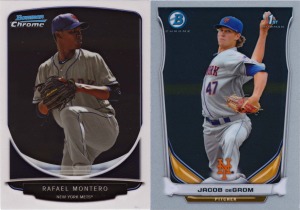
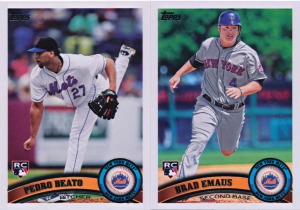
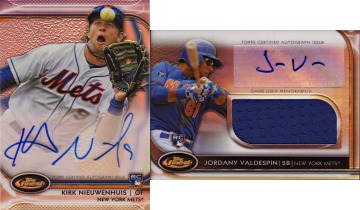
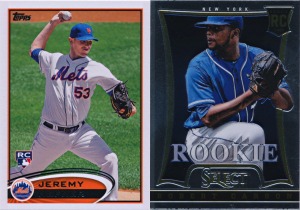
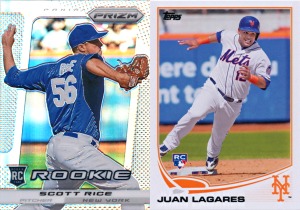
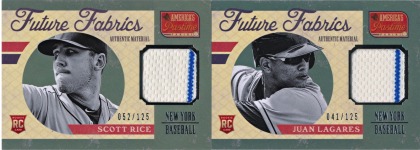
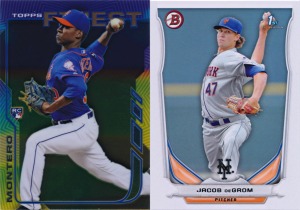
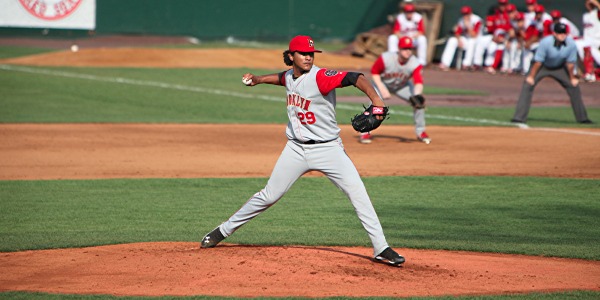
Comments are closed.